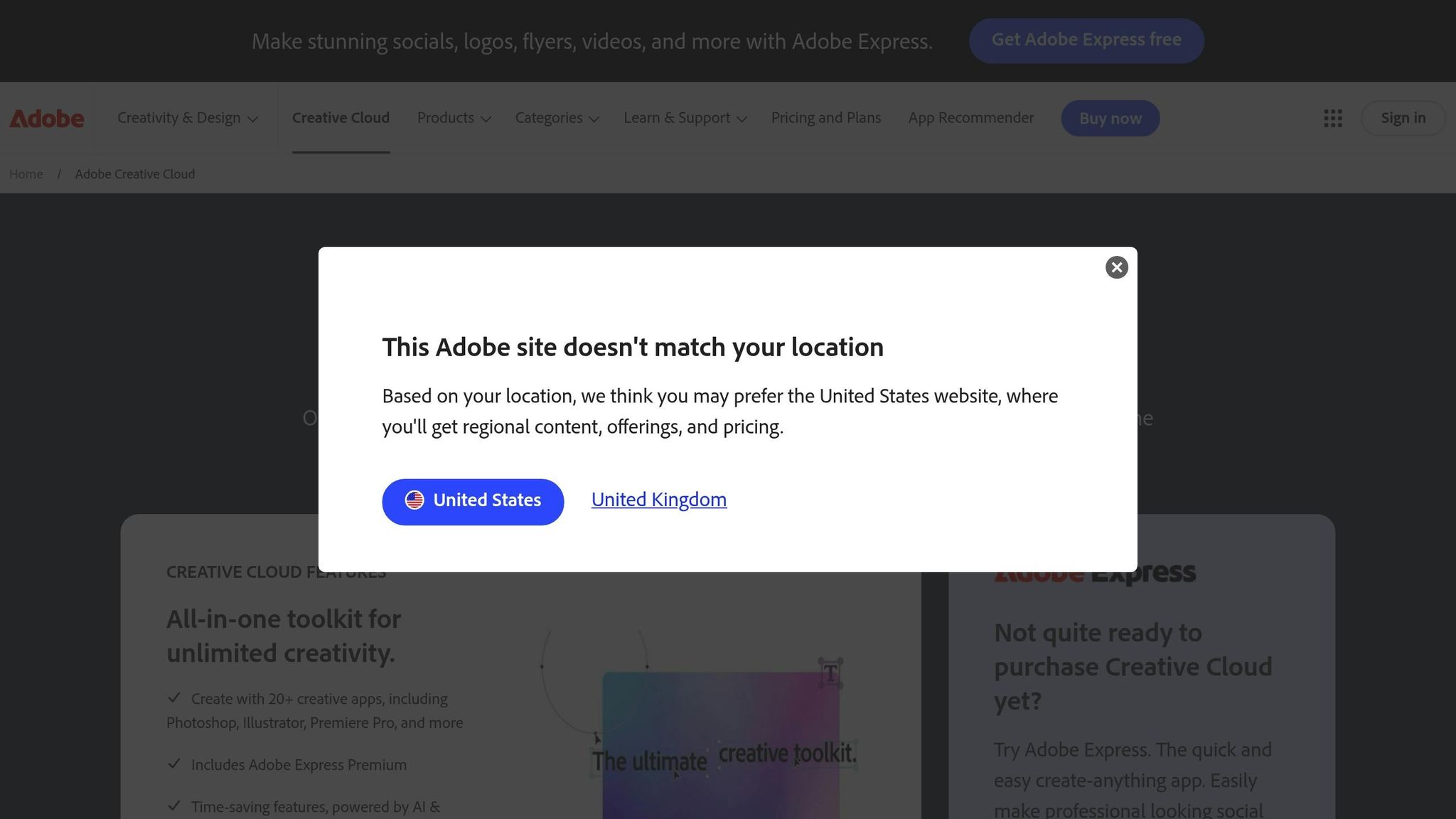Shantanu Narayen: Redefining Creative Leadership at Adobe
Explore how transformative leadership reshaped a major software company, driving innovation and customer-centric growth through strategic decisions.

Shantanu Narayen, Adobe's CEO since 2007, transformed the company from selling boxed software to a cloud-first subscription model. This bold shift, despite early scepticism, led to:
- Revenue Growth: From $3.16 billion in 2007 to over $12 billion by 2021.
- Market Capitalisation Surge: From $11 billion in 2008 to $297 billion by 2021.
- Recurring Revenue: Increased from 5% to over 90% by 2023.
His leadership focused on long-term vision, customer-centric innovation, and data-driven decisions. By prioritising customer needs and embracing change, Narayen turned Adobe into a leader in digital transformation. His journey offers clear lessons on navigating organisational change with patience, clarity, and purpose.
Leadership lessons from Adobe’s CEO | Masters of Scale

Shantanu Narayen's Early Career Path
Shantanu Narayen's professional journey began in India and flourished in Silicon Valley, where he honed the leadership skills that would later define his tenure at Adobe. His formative experiences laid the groundwork for the bold decisions he would make as a leader.
"We are all where we come from and India shaped who I am." - Shantanu Narayen
From India to Silicon Valley
Narayen's upbringing in India played a central role in shaping his leadership style. Growing up, he learned the importance of resourcefulness, a lesson deeply rooted in his environment. His parents instilled values like education, discipline, and hard work - principles that have been his guiding compass throughout his career. Additionally, India’s rich cultural diversity gave him a nuanced understanding of working with people from different backgrounds, an asset in managing global teams. He also recognised the entrepreneurial energy and innovative spirit present in his home country, which influenced his approach to business.
His Silicon Valley journey began in 1986 at Measurex Automation Systems, a start-up specialising in computer control systems. This role introduced him to the symbiotic relationship between hardware and software in improving manufacturing processes. From 1989 to 1995, Narayen held senior roles at Apple, contributing to pioneering projects like the Newton and QuickTime. At Apple, he gained invaluable insights into aligning technical innovation with market demands. Following this, he joined Silicon Graphics, where he further sharpened his expertise in technology and business strategy.
Co-founding Pictra Inc.
In 1996, Narayen embraced entrepreneurship by co-founding Pictra Inc., one of the first companies to focus on digital photo-sharing. As director, he balanced the technical and creative aspects of the business, introducing early concepts in digital photo-sharing. While Pictra faced financial challenges, the experience proved transformative.
"Pictra was the best thing that happened to me." - Shantanu Narayen
Operating in a lean start-up environment, Narayen adopted a mindset of persistence and problem-solving, which would later become integral to his leadership at Adobe. His time at Pictra also reinforced the idea that varied experiences in the tech industry often outweigh traditional measures of success.
"Early in your career, get a whole bunch of diverse experiences. And I think that's what makes the Valley such a special place. Nobody cares whether you were quote-unquote successful in that company. It's all a question of how do you get more tools." - Shantanu Narayen
These early experiences, both the triumphs and the setbacks, shaped the leadership qualities that would eventually help him transform Adobe. His journey through diverse roles and challenges gave him the tools to innovate and lead with vision.
Adobe's Shift: From Boxed Software to Creative Cloud

When Shantanu Narayen took the helm as CEO in 2007, Adobe was thriving on its boxed software model. But he saw the writing on the wall - cloud computing and subscription services were the future. Betting big, he set out to completely transform the company.
The Creative Cloud Transformation
In May 2013, Adobe made a bold move, announcing its shift to Creative Cloud. This marked a significant departure from selling perpetual licences to offering subscription-based services. The change wasn’t just about pricing - it reimagined how creative professionals accessed Adobe’s tools. The shift was driven by the growing dominance of cloud computing, faster internet speeds, and the rising demand for continuous updates and collaborative features. Narayen recognised that the traditional cycle of releasing major software updates every 18–24 months no longer fit the pace of modern technology.
"You simply cannot deliver cutting‐edge experiences with an antiquated infrastructure."
- Shantanu Narayen
But not everyone was on board. The decision sparked backlash, including a Change.org petition that garnered over 30,000 signatures, and even within Adobe, there were doubts about whether customers would embrace the change. The company's revenue took a hit, dropping from £3.5 billion in 2012 to £3.3 billion in 2013 as it navigated this new model.
Despite the turbulence, Narayen’s data-driven strategy paid off. Adobe restructured its operating model to optimise every stage of the customer experience - from discovery to renewal - identifying and addressing pain points along the way. By the end of 2015, Creative Cloud subscriptions had surged to over 6 million, up from just 1.4 million in 2013. Revenue followed suit, bouncing back to £4.7 billion in 2016, while the stock price soared from around £28 in 2012 to over £80 by the end of 2016. By 2023, recurring revenue accounted for over 90% of Adobe’s income, and the company’s stock value had increased tenfold in just a decade.
This transformation wasn’t just a financial win - it laid the groundwork for a customer-centric approach to navigating change.
Managing Change with Customer Focus
After the initial shift, Narayen doubled down on engaging with customers. Instead of brushing off concerns, Adobe leaned in, holding listening sessions and accelerating the development of new features based on user feedback. To address cost worries, the company introduced special pricing for students and educators and invested heavily in retraining its sales and support teams. By 2015, Adobe’s capital expenditures had doubled from £0.12 billion in 2012 to over £0.24 billion, underscoring its commitment to strengthening its cloud infrastructure.
Customer feedback became central to product development. Through surveys and focus groups, Adobe fine-tuned Creative Cloud, prioritising features that mattered most to users.
"We are obsessed with metrics, not opinions."
- Shantanu Narayen
Transparency played a critical role in the transition. Mark Garrett, Adobe’s former CFO, emphasised the importance of clear communication with all stakeholders. Convincing investors, customers, employees, and partners required consistent, open dialogue.
Narayen’s leadership showed that transformation isn’t just about having a bold vision - it’s about staying committed to delivering value to customers and persevering through resistance. The success of Creative Cloud ultimately proved that aligning a business model with customer needs - even when it means a complete overhaul - is the key to sustainable growth.
Major Achievements Under Narayen's Leadership
Shantanu Narayen's time as CEO has been defined by bold decisions, strategic acquisitions, and consistent financial growth. He has successfully steered Adobe from its origins as a traditional software company to a leader in cloud-based solutions.
Key Acquisitions Driving Growth
Narayen's acquisition strategy has played a central role in expanding Adobe's capabilities. One of the most notable moves was the £2.6 billion purchase of Macromedia, which brought tools like Flash and Dreamweaver into Adobe's portfolio. This acquisition significantly widened Adobe's reach in the consumer and web markets.
In 2009, Adobe acquired Omniture for £1.4 billion, a move initially met with scepticism and described as "off strategy and non-complementary". However, this decision proved transformative. As Narayen explained at the time:
"We will enable advertisers, media companies and e-tailers to realise the full value of their digital assets".
This acquisition laid the groundwork for Adobe's Experience Cloud, integrating web analytics with its design tools. By 2020, the Experience Cloud was generating approximately £2.6 billion in revenue.
Narayen continued to expand Adobe's reach with the 2018 acquisitions of Magento for £1.3 billion and Marketo for £3.7 billion. These investments in e-commerce and marketing automation further bolstered Adobe's digital experience offerings, cementing its position as a leader in the industry.
Financial Growth and Market Success
Adobe's financial trajectory under Narayen's leadership has been nothing short of remarkable. Revenue grew from approximately £2.7 billion in 2008 to around £12.1 billion in 2021, with market capitalisation increasing by over 87% since 2012. The transition to a subscription-based model with Creative Cloud played a key role in this success. By 2017, recurring revenue accounted for 86% of Adobe's total revenue, amounting to roughly £5.6 billion.
The company has also seen significant growth in its workforce, expanding from around 6,000 employees to 22,000 during Narayen's tenure. In 2018, Adobe earned a place on the Fortune 500 for the first time. These milestones reflect more than just financial success - they highlight a profound shift in how creative and marketing professionals operate, with Adobe firmly positioned as a leader in digital transformation.
Leadership Lessons from Shantanu Narayen
Shantanu Narayen's leadership at Adobe offers a masterclass in steering organisational change. His tenure shows that transformation is not just about having a bold vision; it’s about consistently delivering on that vision, making decisions based on solid data, and always keeping the customer at the centre of every move.
Consistency and Clear Vision
When Adobe transitioned to a cloud-first model in 2012, Narayen's steady hand was crucial. The shift to the Creative Cloud subscription service initially faced scepticism from customers and employees alike. Yet, Narayen remained transparent about the company’s goals, addressing concerns head-on and ensuring everyone understood the long-term benefits of the change.
His leadership style highlights the importance of balancing a clear, unwavering purpose with the patience to let teams adapt at their own pace. This combination of consistency and adaptability became the backbone of Adobe’s success.
Data-Driven Leadership and Design Thinking
One of Narayen’s key contributions has been embedding data into Adobe’s decision-making culture. Moving away from intuition-driven decisions, he championed an evidence-based approach, which proved transformative for the company.
A pivotal part of this shift was redefining how success was measured. Instead of focusing on product shipments, Adobe began prioritising customer outcomes. This change allowed the company to identify areas for improvement and opportunities for innovation more effectively.
"We are obsessed with metrics, not opinions." - Shantanu Narayen
This focus on data-driven accountability ensured that even in uncertain times, decisions were grounded in facts rather than hierarchy or tradition. By building a culture centred on measurable results, Adobe was able to make bold, customer-focused decisions with confidence.
Customer-Focused Business Change
Throughout Adobe’s transformation, Narayen consistently prioritised customer needs - even when it required short-term sacrifices. For example, during the pandemic, Adobe allowed struggling customers to defer payments, a move that underscored the company’s commitment to its users during difficult times.
This customer-first mindset also drove Adobe’s strategic investments, as Narayen’s leadership placed a premium on understanding customer needs for seamless digital experiences. His approach went beyond simply gathering feedback; it involved reshaping operations to align with customer success.
Conclusion: Shantanu Narayen's Impact on Leadership
Shantanu Narayen’s tenure at Adobe is a masterclass in transformational leadership. His understated yet impactful style shows that meaningful change doesn’t require fanfare - it demands a clear vision, decisions rooted in data, and an unwavering commitment to customers. The remarkable financial turnaround Adobe experienced under his guidance isn’t just a one-off success; it reflects a deeply ingrained leadership philosophy.
During Narayen’s time at the helm, Adobe’s recurring revenue saw a significant rise, and its market capitalisation reached impressive new heights. These achievements highlight the power of his customer-first approach in driving sustainable growth.
The lessons from Narayen’s leadership extend well beyond Adobe. His focus on calculated risk-taking serves as a valuable roadmap for leaders navigating volatile and unpredictable markets. Equally important is his dedication to empowering employees, which underscores the human element of transformation. As Narayen himself puts it:
"People do their best work when they embrace what the company is setting out to achieve and when the mission, vision and values of the company resonates with them" - Shantanu Narayen, Adobe CEO
This belief in aligning personal and organisational values as a driver of success is paired with his insistence on evidence-based decision-making, ensuring accountability at every level.
For leaders tackling today’s transformation challenges, Narayen’s approach offers actionable insights: prioritise your customers, rely on data rather than gut instinct, and understand that lasting change comes from consistent effort, not abrupt moves. In a world shaped by rapid technological advances, Narayen’s leadership demonstrates that clarity of purpose, combined with a focus on both people and customers, remains the ultimate competitive advantage.
FAQs
How did Shantanu Narayen's early experiences shape his leadership approach at Adobe?
Shantanu Narayen's early years in Hyderabad, India, offer a glimpse into the roots of his leadership style. Growing up with a mother who taught literature and a father who managed a business, he was surrounded by influences that combined creativity, discipline, and entrepreneurial thinking. These traits have become hallmarks of his calm yet forward-thinking leadership at Adobe.
Academically, Narayen built a solid foundation with a degree in Electronics from Osmania University, followed by a Master's in Computer Science from Bowling Green State University. This technical expertise and problem-solving mindset equipped him to steer Adobe through a major transformation. Under his guidance, the company shifted from traditional software to a cloud-based platform, relying on steady, data-informed decisions rather than abrupt changes. His approach blends innovation with a clear sense of purpose and a deep commitment to understanding customer needs.
What challenges did Adobe face when shifting to a cloud-based subscription model, and how did it overcome them?
Adobe faced several hurdles when shifting to a cloud-based subscription model. Key challenges included managing customer expectations, dealing with revenue instability, and combating widespread software piracy. The traditional model of one-off purchases led to unpredictable income and limited Adobe's ability to provide the frequent updates that users were starting to demand. On top of this, piracy was a major issue, with unauthorised versions of its software becoming increasingly easy to access.
To tackle these problems, Adobe launched the Creative Cloud subscription service. This move brought a steady stream of revenue, thanks to consistent cash flow, and improved customer satisfaction by delivering regular updates and new features. By aligning its services with changing user expectations and strengthening security measures, Adobe not only grew its customer base but also significantly increased its market value, proving the effectiveness of its bold transformation.
How has Shantanu Narayen’s data-driven leadership shaped Adobe’s digital transformation journey?
Shantanu Narayen has steered Adobe through a remarkable transformation, turning it into a cloud-first leader in creative software. By championing a data-driven approach, where key performance indicators (KPIs) and analytics shape decisions, he guided Adobe's seamless shift from selling boxed software to a subscription-based model. This bold move not only deepened customer engagement but also built stronger, lasting loyalty.
Narayen’s leadership has seen Adobe harness data to stay nimble, quickly adapting to market shifts and evolving customer demands. His commitment to innovation and prioritising customer-focused solutions has fuelled impressive growth, firmly establishing Adobe as a frontrunner in the digital creative industry.
